The Water Sink Market is estimated to be valued at USD 49.9 billion in 2025 and is projected to reach USD 65.8 billion by 2035, registering a compound annual growth rate (CAGR) of 2.8% over the forecast period.
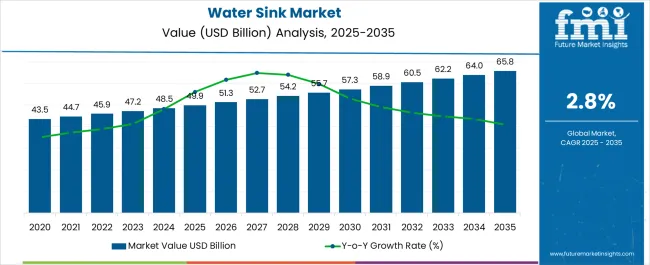
| Metric | Value |
|---|---|
| Water Sink Market Estimated Value in (2025 E) | USD 49.9 billion |
| Water Sink Market Forecast Value in (2035 F) | USD 65.8 billion |
| Forecast CAGR (2025 to 2035) | 2.8% |
The water sink market is expanding steadily, supported by increasing residential construction, urbanization, and evolving consumer preferences for functional and aesthetic kitchen and bathroom fittings. Industry updates and company product portfolios have emphasized the growing demand for sinks that combine durability, modern design, and ease of maintenance. Rising disposable incomes and a focus on home improvement trends have fueled product replacement cycles, while hospitality and commercial facilities have also expanded the adoption of high-performance sink solutions.
Manufacturers have been investing in advanced materials and innovative coatings that resist stains, corrosion, and scratches, improving product longevity. Additionally, sustainability considerations have driven interest in recyclable and eco-friendly materials, particularly in developed markets.
Looking forward, the market is expected to benefit from technological integration in smart kitchens, the rise of modular designs, and expansion in emerging economies where housing projects and household renovations are increasing. Growth will be concentrated in segments led by drop-in sinks, stainless steel as the primary base material, and household applications due to their versatility, cost-effectiveness, and widespread consumer adoption.
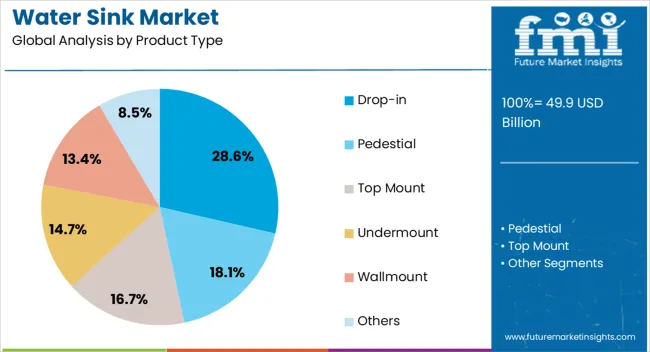
The Drop-in segment is projected to account for 28.6% of the water sink market revenue in 2025, maintaining a significant share due to its ease of installation and affordability. This segment’s growth has been supported by its compatibility with a wide variety of countertop materials, making it a preferred choice for both new constructions and renovations.
Manufacturers have continued to refine drop-in sink designs to enhance aesthetic appeal while retaining their functional advantages. The segment has also benefited from widespread availability across multiple price ranges, catering to both budget-conscious consumers and premium buyers.
Retail and wholesale channels have consistently reported strong demand for drop-in sinks in residential markets, further cementing their position. As homeowners prioritize cost-effective yet reliable sink solutions, the Drop-in segment is expected to sustain its role as a major contributor in the water sink market.
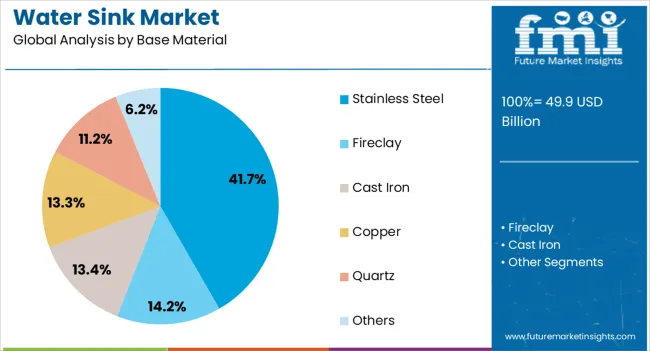
The Stainless Steel segment is projected to contribute 41.7% of the water sink market revenue in 2025, holding its position as the dominant base material. Growth has been driven by the material’s durability, resistance to corrosion, and hygienic properties, which make it particularly suitable for kitchens.
Industry sources have noted that stainless steel’s cost-effectiveness and recyclability further enhance its appeal among both manufacturers and consumers. Product innovations such as noise-reduction technology, brushed finishes, and anti-scratch coatings have expanded consumer adoption in both residential and commercial markets.
Additionally, stainless steel’s versatility in supporting a range of sink formats and designs has reinforced its market strength. With rising demand for long-lasting and low-maintenance sink solutions, the Stainless Steel segment is expected to retain its leadership in the market.
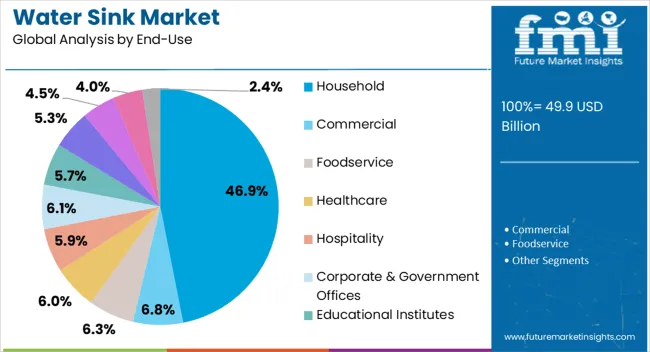
The Household segment is projected to capture 46.9% of the water sink market revenue in 2025, establishing itself as the leading end-use category. This growth has been supported by increased housing development, renovation projects, and consumer investments in modern kitchen and bathroom designs.
Market reports and industry announcements have highlighted a strong focus on household sinks that combine functionality with aesthetics, catering to changing lifestyle preferences. The household segment has also benefited from the rise of organized retail, online distribution platforms, and modular home design concepts, which have broadened consumer access to a variety of sink styles and finishes.
Additionally, rising consumer awareness of hygiene and convenience has driven adoption of easy-to-clean and durable sinks. As residential construction expands globally and home improvement spending continues to rise, the Household segment is expected to remain the primary driver of demand in the water sink market.
The global water sink market witnessed steady growth from 2020 to 2025, with a CAGR of 2.1%. During this period, increasing awareness of water conservation, kitchen remodeling, and advancements in sink technology were key contributors to market expansion.
Looking ahead, the market outlook for 2025 to 2035 is highly promising, projected to witness a significant surge in demand, with an anticipated CAGR of 2.8%. The forecast period reflects a remarkable acceleration in growth, driven by innovative trends like smart sinks, eco-friendly materials, and personalized designs.
Factors such as the rising trend of smart homes and increased emphasis on sustainable living are expected to fuel this rapid expansion. Additionally, the growing interest in wellness-centric designs and the integration of IoT technology in sinks will further propel the market growth during the forecast period. The industry's focus on water conservation solutions and the increasing number of multi-generational households will contribute to the market's upward trajectory.
The global water sink market overall is poised to undergo a transformative phase, characterized by robust growth and dynamic innovations, shaping kitchen and bathroom spaces with cutting-edge designs and sustainable solutions. Industry players are set to embrace the opportunities presented by changing consumer preferences and technological advancements to drive the market toward a prosperous and sustainable future.
Over the past couple of years, the water sink market has witnessed a gradual increase in the demand for traditional farmhouse water sinks in the household sector. Customers these days prefer bigger, single-basin farmhouse water sinks, which, according to them, provide a perfect blend of beauty and simplicity.
Farmhouse water sinks easily adapt to the various types of kitchen and bathroom designs trending in the market. Hence, there has been an increase in the demand for farmhouse water sinks from households as well as commercial sectors such as the hospitality, healthcare and foodservice industries.
Over the past couple of years, companies in the water sink market are following a more environmental-friendly approach, which entails the incorporation of warm and natural elements as well as earthen luxury components, especially in the household and hospitality sectors.
The consumer is now looking for materials that are derived from nature or those that mimic the sight of nature. This makes kitchens as well as bathrooms look attractive and spacious. The warmth of wooden surfaces of water promotes a natural touch to household interiors.
Various cookware and bathroom ware products from well-known brands come with a 10-year warranty. This could result in an inventory overhang and reduce a company's manufacturing capacity.
Due to high labor costs, consumers are less likely to repair bath fittings. As a result, the low replacement rate of bath fittings is a major factor limiting the worldwide water sink market's growth in terms of volume sales.
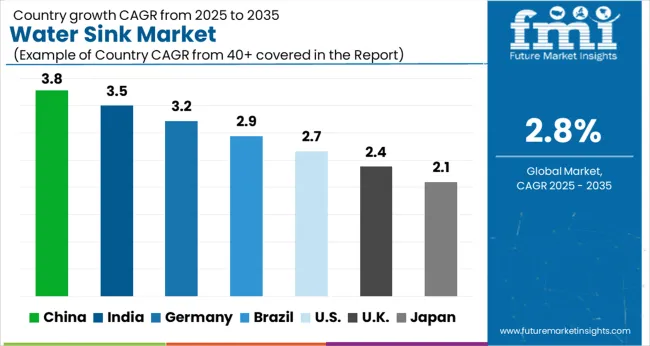
North America is expected to remain one of the key markets, accounting for majority of market share whereas the United States is expected to hold a significant CAGR of 2.9% during the forecast period. Water use at home in the United States (water from the tap, toilet, dishwasher, etc.) amounts to around 138 gallons per household per day, or 60 gallons per person per day, according to the Water Footprint Calculator.
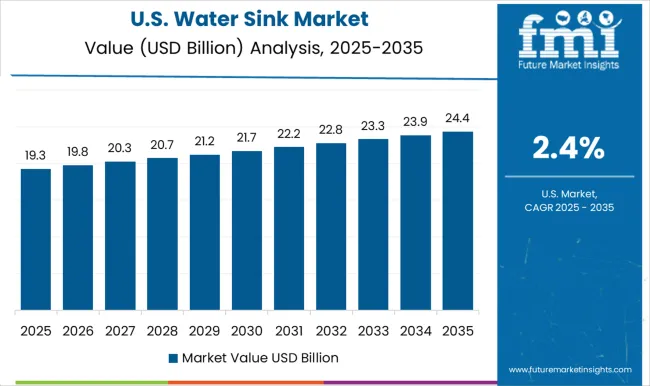
Americans, on the other hand, utilize water throughout their homes, with the bathroom being the most popular, followed by the laundry room. Hence, the high utilization of water in the bathrooms, laundry rooms etc. is expected to increase the demand for high capacity water sink in the country.
Russia is expected to hold a significant CAGR of 2.5% during forecast period. The market in the country is growing due to the increasing acceptance of various designed and printed water sinks across a variety of commercial applications. Because of its enormous population, Europe dominates the water sink market.
Russia, on the other hand, holds a prominent share in the water sink market because it produces a multi-faceted commodity in the shape of many stainless steel kinds, expanding international trade beyond the region. Moreover, dishwashing accounts for more than half of the tap water used in European kitchens.
Water sink sales in India are expected to register a CAGR of around 2.3% from 2025 to 2035. The Indian government is organizing various programs and activities to encourage people to drink clean and safe tap water, which is raising awareness among Indians.
The Government of India, for example, implemented the Jal Jeevan Mission-Har Ghar Jal, which intends to provide potable water in sufficient quantity and of prescribed quality to every rural household in the country, including tribal areas, through regular and long-term tap water connections by 2025. As a result of these activities, the water sink demand across the country is likely to increase.
In terms of product type, drop-in water sink is expected to register a CAGR of 2.9% during the forecast period. Sink basins that are been installed on top of the kitchen counter are known as drop-in water sinks, self-rimming sinks, overmount sinks, or top-mount sinks. They're often less expensive to purchase as compared to undermount sinks.
On the basis of base material, stainless steel water sink are expected to increase at a CAGR of 3.1%. Stainless steel sink is the most popular base material owing to its characteristics such as corrosion resistance, fire and heat resistance, hygiene, strength to weight advantage, ease of fabrication, impact resistance, antibacterial value, and long-term value.
In terms of end use, commercial segments such as (hotels, schools, government offices, hospitals etc.) are expected to register a CAGR of 3.3% during the forecast period. Due to the increase in urbanization and industrialization, commercial establishments have started maintaining spacious and attractive properties. As a result, they strive to keep their washrooms clean and environment-friendly.
The commercial segment, which comprises of offices, resorts as well as the hotel industry, look out ways to promote creativity in these areas. Hence, there is an increase in the demand for upgraded versions of water sink products such as top-mount water sinks, undermount water sinks as well as wall mount water sinks.
The water sink market presents a competitive landscape with key players vying for market share. Established brands like Franke, Kohler, and Blanco dominate the industry with their diverse product portfolios, encompassing smart sinks, sustainable materials, and innovative designs. Newer entrants, such as Elkay and Kraus, are gaining traction with their focus on customizable options and affordable yet premium sink solutions.
The competition centers on incorporating cutting-edge technology, eco-consciousness, and user-centric designs to cater to evolving consumer demands. Market players are striving to differentiate themselves through quality craftsmanship, enhanced functionality, and eco-friendly initiatives to stay ahead in this dynamic and ever-evolving market.
Strategies for Water Sink Manufacturers to Expand in the Market:
| Report Attribute | Details |
|---|---|
| Market Value in 2025 | USD 47.22 billion |
| Market Value in 2035 | USD 62 billion |
| Growth Rate | CAGR of 2.8% from 2025 to 2035 |
| Base Year for Estimation | 2025 |
| Historical Data | 2020 to 2025 |
| Forecast Period | 2025 to 2035 |
| Quantitative Units | Revenue in USD billion and CAGR from 2025 to 2035 |
| Report Coverage | Revenue Forecast, Company Ranking, Competitive Landscape, Growth Factors, Trends and Pricing Analysis |
| Segments Covered | Product Type, Base Material, Sales Channel, Region |
| Regions Covered | North America; Latin America; Western Europe; Eastern Europe; South Asia and Pacific; East Asia; Middle East & Africa |
| Key Countries Profiled | United States, Canada, Brazil, Mexico, Germany, United Kingdom, France, Spain, Italy, Poland, Russia, Czech Republic, Romania, India, Bangladesh, Australia, New Zealand, China, Japan, South Korea, GCC Countries, South Africa, Israel |
| Key Companies Profiled | Blanco America, Inc.; Crown Products (Kent) Limited; Elkay Manufacturing Company; Franke Kitchen Systems, LLC; Huida Sanitary Ware Co., Ltd.; JULIEN INC.; Kohler Co. (Sterling); Kraus USA INC.; LIXIL Corporation (American Standard Brand); Moen Incorporated; Mountain Plumbing Products; Roca Sanitario, S.A.; ROHL LLC.; Schock GmbH; Stern-Williams Co. Inc. |
| Customization& Pricing | Available upon Request |
The global water sink market is estimated to be valued at USD 49.9 billion in 2025.
The market size for the water sink market is projected to reach USD 65.8 billion by 2035.
The water sink market is expected to grow at a 2.8% CAGR between 2025 and 2035.
The key product types in water sink market are drop-in, pedestial, top mount, undermount, wallmount and others.
In terms of base material, stAInless steel segment to command 41.7% share in the water sink market in 2025.






Full Research Suite comprises of:
Market outlook & trends analysis
Interviews & case studies
Strategic recommendations
Vendor profiles & capabilities analysis
5-year forecasts
8 regions and 60+ country-level data splits
Market segment data splits
12 months of continuous data updates
DELIVERED AS:
PDF EXCEL ONLINE
All-In-One Under Sink Water Purifier Market Size and Share Forecast Outlook 2025 to 2035
Water Vapor Permeability Analyzers Market Size and Share Forecast Outlook 2025 to 2035
Water and Waste Water Treatment Chemical Market Size and Share Forecast Outlook 2025 to 2035
Water-cooled Walk-in Temperature & Humidity Chamber Market Size and Share Forecast Outlook 2025 to 2035
Waterless Bathing Solution Market Size and Share Forecast Outlook 2025 to 2035
Water Treatment System Market Size and Share Forecast Outlook 2025 to 2035
Waterborne UV Curable Resin Market Size and Share Forecast Outlook 2025 to 2035
Water Treatment Chemical Market Size and Share Forecast Outlook 2025 to 2035
Water Adventure Tourism Market Forecast and Outlook 2025 to 2035
Water Packaging Market Forecast and Outlook 2025 to 2035
Water Soluble Bag Market Size and Share Forecast Outlook 2025 to 2035
Water Leak Sensors Market Size and Share Forecast Outlook 2025 to 2035
Water-soluble Packaging Market Size and Share Forecast Outlook 2025 to 2035
Water Leak Detection System for Server Rooms and Data Centers Market Size and Share Forecast Outlook 2025 to 2035
Water and Wastewater Treatment Equipment Market Size and Share Forecast Outlook 2025 to 2035
Water Treatment Market Size and Share Forecast Outlook 2025 to 2035
Water Underfloor Heating Thermostat Market Size and Share Forecast Outlook 2025 to 2035
Water Activity Meter Market Size and Share Forecast Outlook 2025 to 2035
Water Leakage Tester Market Size and Share Forecast Outlook 2025 to 2035
Waterstops Market Size and Share Forecast Outlook 2025 to 2035

Thank you!
You will receive an email from our Business Development Manager. Please be sure to check your SPAM/JUNK folder too.
Chat With
MaRIA